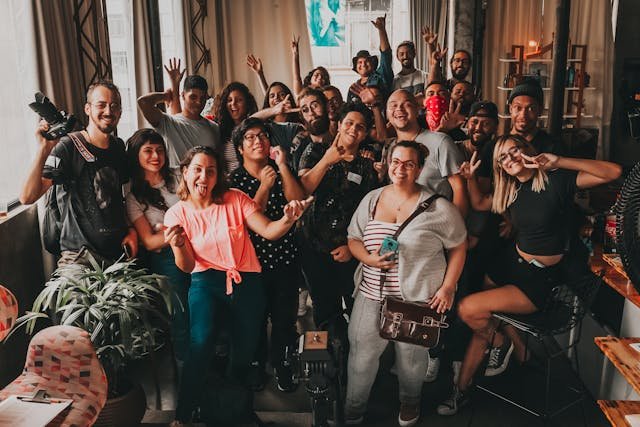In today’s competitive landscape, customer loyalty is more valuable than ever. A strong customer loyalty program doesn’t just encourage repeat purchases; it strengthens the emotional bond customers feel with your brand. When times get tough, these loyal customers are the ones who continue to engage, support, and champion your brand, even when new customers may be harder to come by. Building a loyalty program is an investment in resilience—a strategy that helps you weather economic fluctuations, maintain stable revenue, and reduce dependency on constantly acquiring new customers.
In this article, we’ll delve into how you can design and implement a loyalty program that genuinely resonates with customers, making them more likely to stick with your brand through ups and downs. Whether you’re starting from scratch or enhancing an existing program, here’s a guide to creating a loyalty program that does more than reward purchases; it creates lasting connections.
Step 1: Understanding the True Purpose of Loyalty Programs
Go Beyond Transactional Rewards
Loyalty programs shouldn’t be just about discounts or points. While these incentives are essential, a truly effective loyalty program deepens the relationship between the brand and the customer. To create a program that fosters resilience, focus on building an experience that makes customers feel valued and connected, rather than merely enticing them with discounts.
For example, think about offering exclusive experiences, like early access to products, invites to events, or behind-the-scenes content. These non-monetary rewards make customers feel part of the brand’s journey. By building an emotional connection, you create a sense of belonging that goes beyond individual transactions.
Recognize and Celebrate Customer Loyalty
People love to be recognized for their loyalty. Showing appreciation isn’t only about rewards; it’s about making customers feel seen and appreciated. Simple gestures, like sending thank-you messages, celebrating customer milestones, or recognizing birthdays, enhance the loyalty experience. This personal touch strengthens the emotional bond and encourages long-term loyalty.
For instance, a coffee shop might celebrate a customer’s 50th purchase with a personalized message and a special offer. These small gestures make customers feel valued and encourage them to keep engaging with the brand, which ultimately fortifies brand resilience.
Step 2: Designing a Loyalty Program That Aligns with Your Brand

Align Rewards with Your Brand Values
To build a loyalty program that resonates deeply, design rewards that reflect your brand’s unique values and personality. This alignment reinforces your brand identity and builds trust, as customers see that the rewards are genuine and relevant.
For example, if sustainability is a core value of your brand, offer eco-friendly rewards, such as reusable products, digital rewards, or donations to environmental causes on behalf of your customers. When rewards align with your brand’s mission, they create a more meaningful experience that strengthens customer loyalty.
Offer Tiered Rewards to Encourage Long-Term Engagement
Tiered loyalty programs provide customers with an incentive to keep engaging with your brand over time. By offering different levels of rewards, you create a structure that encourages customers to stay with you longer to unlock new benefits. This gamification keeps the program exciting and rewarding, helping to prevent customer attrition.
For instance, you might start with a basic membership that offers small perks, like birthday discounts, and progress to higher tiers that include exclusive access, premium customer support, or personalized offers. These tiers reward dedication and make customers feel that the more they engage with your brand, the more value they receive in return.
Step 3: Creating a Seamless and Accessible Loyalty Experience
Make It Easy to Join and Participate
A loyalty program should be simple and intuitive. Avoid complex rules or requirements that might discourage customers from participating. Instead, make it easy to join, track points or rewards, and redeem benefits. A seamless experience enhances satisfaction and keeps customers engaged.
For example, offer a quick sign-up process on your website or app, and provide an easily accessible dashboard where customers can view their points or rewards status. Simple features like automatic point accumulation or one-click redemption improve the experience, making customers more likely to stay engaged.
Use Technology to Personalize the Loyalty Journey
Personalization is key to making customers feel valued. Use data and technology to tailor the loyalty experience based on each customer’s preferences, purchase history, or browsing behavior. Personalized rewards and offers show that your brand understands and appreciates individual customer preferences, building stronger connections.
For example, if a customer frequently buys fitness products, offer them rewards or early access to new items in that category. Using personalization tools, like AI-driven recommendations or targeted email offers, makes your loyalty program feel like it’s been designed just for each customer, enhancing brand loyalty and engagement.
Step 4: Building Community Within Your Loyalty Program

Foster a Sense of Community Among Loyal Customers
Loyalty programs are more than just points; they’re an opportunity to create a community around your brand. A strong community gives loyal customers a place to connect with each other, share their experiences, and celebrate their relationship with your brand. This sense of community makes your brand feel like a shared experience, encouraging deeper loyalty and brand advocacy.
For example, you could create an online group for your loyalty program members, where they can connect, share stories, or participate in brand-hosted events. Some brands even host exclusive events, such as live Q&A sessions, product launches, or workshops for their top-tier members. A community atmosphere enhances brand loyalty, as it gives customers a sense of belonging and pride in supporting your brand.
Engage Customers Through User-Generated Content and Social Proof
Encourage loyal customers to share their experiences through user-generated content (UGC), such as photos, testimonials, or social media posts. Highlighting this content in your loyalty program adds a layer of social proof and gives customers a voice within your brand. Seeing other satisfied customers reinforces trust and motivates others to join the program.
For instance, create a hashtag for your loyalty program or a monthly feature where you showcase members’ stories. Offer rewards or points for sharing their experiences, creating a win-win situation that promotes both engagement and brand visibility. UGC creates a virtuous cycle where loyal customers reinforce your brand story, attracting new customers and building resilience.
Step 5: Keep Customers Engaged with Consistent and Relevant Communication
Use Personalized Communications to Keep the Program Top-of-Mind
Consistent communication is essential to remind customers about the benefits of your loyalty program and keep them engaged. Send personalized updates, like reminding them of points that are about to expire or new rewards available. Tailored messages keep the program relevant and remind customers of the value they’re receiving.
For example, if a customer is close to reaching the next tier, send an encouraging message that highlights the benefits they’ll unlock. Or, if you’re introducing new rewards, let customers know with a personalized email showcasing options based on their past purchases. Personalized communication keeps your brand and loyalty program front and center, reinforcing the value and encouraging continuous engagement.
Offer Surprises and Delightful Moments
Unexpected rewards or experiences are memorable and make customers feel special. Incorporating surprise rewards—such as extra points on birthdays or unexpected discounts—adds excitement to the loyalty program and makes customers feel appreciated. These delightful moments help keep customers emotionally connected to your brand.
For instance, send a surprise “thank you” reward to customers who reach a certain milestone or a free upgrade to a higher tier for a limited time. By incorporating these unexpected rewards, you create positive experiences that make customers feel valued, reinforcing loyalty and resilience in their relationship with your brand.

Related: Check out our free tools:

Step 6: Measuring and Adapting Your Loyalty Program for Long-Term Success
Track Metrics That Reflect True Engagement and Retention
To understand the impact of your loyalty program, monitor metrics that reflect customer engagement and retention. Look at repeat purchase rates, program participation levels, customer lifetime value (CLV), and customer satisfaction scores. These metrics help you assess if your program truly drives loyalty or if it needs adjustments.
For example, if you notice high enrollment but low participation, it may be time to reevaluate the rewards or simplify the structure. By focusing on engagement metrics, you gain insight into how well your program resonates with your audience, allowing you to make data-driven adjustments that increase its effectiveness.
Continuously Innovate Based on Customer Feedback
Your loyalty program should be dynamic, evolving to meet the changing needs and preferences of your customers. Gather feedback regularly through surveys, reviews, or direct conversations to understand what customers value most and what areas could be improved. Use this feedback to adjust the program, introducing new rewards, refining processes, or enhancing the experience.
For example, if customers express interest in more experience-based rewards, consider adding elements like virtual workshops or exclusive Q&A sessions. Adapting based on customer feedback not only improves the program’s effectiveness but also shows customers that you’re listening and committed to enhancing their experience. This responsiveness strengthens the relationship and reinforces loyalty.
Step 7: Turning Loyal Customers Into Brand Advocates

Encourage Referrals Through Loyalty-Based Incentives
Loyal customers are more likely to refer friends and family, especially when incentivized through your loyalty program. Introduce referral rewards that encourage loyal customers to spread the word about your brand, transforming them into advocates who actively contribute to your growth. This not only brings in new customers but reinforces loyalty among existing ones.
For instance, offer extra points, discounts, or exclusive rewards for each successful referral. A referral reward can be a win-win, where both the referrer and the new customer benefit. This strategy amplifies the reach of your loyalty program and fosters a network of customers who advocate for your brand, enhancing resilience.
Recognize and Reward Brand Advocacy
When customers go out of their way to support and promote your brand, acknowledge and reward their efforts. Whether they’re writing positive reviews, sharing on social media, or participating in events, recognize this advocacy within your loyalty program. Rewards for advocacy go beyond standard points—they reinforce an emotional connection and show appreciation for loyalty that goes beyond purchases.
For example, create a “Brand Champion” tier or a badge for customers who consistently advocate for your brand. Offer them special perks, like exclusive previews, one-on-one interactions with your team, or limited-edition items. Recognizing brand advocacy strengthens the bond and encourages even more engagement, fostering a community that supports and uplifts your brand.
Step 8: Using Data to Refine and Personalize the Loyalty Experience
Leverage Customer Data to Enhance Personalization
Data is a powerful tool for making your loyalty program feel genuinely tailored to each customer. By tracking individual preferences, purchase history, and engagement patterns, you can offer rewards and experiences that feel personalized. The more your program aligns with what customers value, the stronger their loyalty becomes.
For example, if a customer consistently purchases certain types of products, you can provide tailored rewards that reflect these interests, such as early access to similar products or exclusive discounts in that category. Additionally, using insights from browsing behavior can help you create targeted offers that encourage repeat purchases, making the loyalty experience relevant and engaging for each customer.
Use Predictive Analytics to Anticipate Customer Needs
Predictive analytics can help you anticipate what customers may need or want next, enabling you to proactively offer rewards or services that increase satisfaction. For example, if a customer tends to shop at certain times of the year, your program can automatically suggest timely offers or reminders based on this behavior. This level of personalization adds a thoughtful touch that customers remember, reinforcing their connection to your brand.
For instance, if analytics reveal that a customer purchases seasonal items each holiday, you can send a special holiday offer in advance. Predictive analytics transforms data into actionable insights, allowing you to create a proactive loyalty experience that keeps customers engaged and appreciated.
Step 9: Integrating Loyalty with Your Overall Brand Strategy

Make Loyalty Part of Your Brand’s Identity
When a loyalty program feels integral to a brand’s identity, customers view it as a natural extension of their experience rather than just an add-on. Integrate loyalty with your brand story and messaging across all channels, showing that appreciation and reward are central to your brand’s values. A loyalty program that aligns seamlessly with your brand reinforces customer trust and engagement.
For example, a brand known for its commitment to wellness can incorporate rewards that emphasize health and well-being, such as discounts on wellness products or points for engaging with health-related content. By making loyalty feel like an organic part of the brand, you strengthen its authenticity and enhance the customer’s experience at every touchpoint.
Align Loyalty Incentives with Brand Goals
Ensure that the rewards and incentives within your loyalty program support your larger brand objectives. If one of your goals is to increase social engagement, offer rewards for customer-generated content or social media shares. If another goal is to drive traffic to new product categories, create incentives that encourage customers to explore these areas. By aligning your program with key business goals, you create a win-win situation where customer loyalty directly supports your brand’s growth.
For example, a fashion brand might offer loyalty points for each social media share or reward points for exploring a new seasonal collection. This approach aligns customer engagement with business growth, making the loyalty program an effective part of your overall strategy.
Step 10: Building Long-Term Loyalty and Reducing Churn
Address Customer Pain Points Through the Loyalty Program
A well-designed loyalty program doesn’t just reward positive behaviors; it can also address potential pain points that might otherwise lead to customer churn. For instance, if customers sometimes experience issues with shipping delays, consider offering loyalty points for any inconvenience, turning a negative experience into a positive interaction.
By acknowledging and rewarding loyalty during challenging situations, you show customers that their satisfaction matters, reinforcing brand loyalty even when things don’t go as planned. This proactive approach not only reduces churn but also builds goodwill, as customers see that your brand values their experience.
Foster Re-Engagement with Dormant Customers
Every loyalty program will encounter customers who become inactive over time. Use targeted re-engagement strategies to reach out to these dormant customers and remind them of the benefits they may be missing. A gentle nudge, such as a bonus reward for logging back in or a personalized message reminding them of their points balance, can spark renewed interest.
For example, you could send an email offering double points on their next purchase or exclusive access to a limited-time promotion. These re-engagement tactics show that you care about your customers and want them to continue benefiting from the program. By reducing churn and fostering long-term loyalty, you create a more resilient customer base that supports your brand’s stability.
Step 11: Evolving the Program Based on Trends and Customer Needs
Stay Updated on Loyalty Program Trends
As technology and customer expectations evolve, so too should your loyalty program. Stay informed about new trends, such as experiential rewards, gamification, and subscription-based loyalty programs, which can add freshness to your approach. Regularly evaluating industry trends ensures that your loyalty program remains relevant and appealing.
For instance, experiential rewards, like invitations to exclusive events or virtual workshops, are increasingly popular as customers seek unique, memorable experiences. By incorporating these trends thoughtfully, you can keep your loyalty program innovative and attractive, making it more likely that customers stay engaged over the long term.
Adapt the Program Based on Feedback and Performance Data
Customer feedback and data are valuable tools for evolving your loyalty program. Gather insights regularly, whether through surveys, social media, or direct feedback, to understand what aspects of the program are most valued and where there may be room for improvement. Making adjustments based on real customer input ensures that the program remains relevant and beneficial.
For example, if feedback indicates that customers find certain rewards too difficult to redeem, simplify the redemption process. Or, if data shows low engagement with specific rewards, consider replacing them with options that better reflect customer preferences. This ongoing optimization keeps your program customer-centric, ensuring it adapts to changing needs and preferences while strengthening loyalty.
Final Thoughts: Building Brand Resilience Through a Strong Loyalty Program
A well-designed loyalty program is more than just a tactic; it’s a strategy for long-term resilience. When customers feel valued, connected, and appreciated, they’re more likely to stay loyal through market changes, economic fluctuations, and new competition. A strong loyalty program builds this connection by making each customer’s experience with your brand meaningful, engaging, and rewarding.
By focusing on personalization, community, consistent communication, and adaptive innovation, you create a loyalty program that doesn’t just offer rewards—it offers relationships. It transforms casual buyers into committed supporters and turns loyal customers into vocal advocates. Each interaction, reward, and acknowledgment strengthens your brand, creating a network of support that helps you weather any storm.
In the end, loyalty is a powerful shield. As you build a program that speaks to your customers’ needs and values, you’ll find that your brand’s resilience grows alongside their loyalty. It’s an investment in trust, connection, and a future where your brand isn’t just surviving but thriving, supported by a loyal community that believes in what you stand for.
READ NEXT:
- Are Vanity Metrics Killing Your Marketing Efficiency? Here’s What to Track Instead
- Pinpointing Digital Marketing ROI: Why Your Metrics Aren’t Telling the Full Story
- Unlocking Real ROI in Digital Marketing: The Hidden Costs Draining Your Budget
- How Misaligned Marketing Funnels Are Blocking Your ROI Potential
- Best Digital Marketing Agency In Santa Ana, California
- Best Digital Marketing Agency In San Francisco, California




















